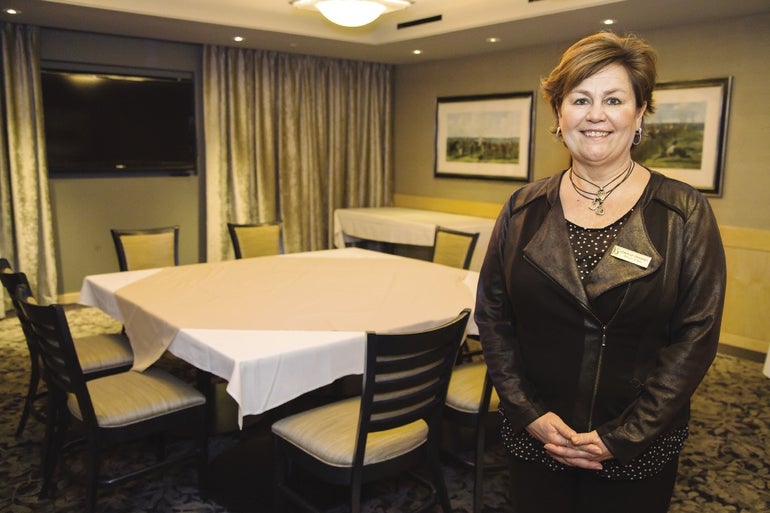The era of clear, efficient long-distance communication has long since arrived. Workers can hop on conference calls from their bedrooms without changing out of their pajamas. High-definition video unites far-flung satellite offices. Employees hash out plans on enterprise social tools such as Microsoft Yammer and Salesforce Chatter from anywhere they can use their phones.
And yet, the power of the in-person meeting remains. A recent nationwide survey of 185 meeting planners by the group Destination Hotels found that 37 percent of respondents expect to spend more this year than last on meetings, while just 12 percent have lower budgets.
So, what does it take to plan a meeting that allows participants to get the most out of an in-the-flesh opportunity to connect with coworkers?
At the Worcester-based UMass Memorial Health Care system, there are numerous internal events to plan each year, including board and board committee meetings and gatherings of clinical and administrative leaders from across the system. Fortunately, said Mary E. Larson, an executive assistant who handles much of the planning, most UMass Memorial meetings take place regularly and are scheduled a year in advance.
Larson said her first move in planning an event is to look for space within the health care system. “But if your needs can’t be met in-house, that’s when we would look to go off-site,” she said.
UMass Memorial tries to work with local organizations, including churches, restaurants and meeting centers, depending on its specific needs, Larson said. She said she looks for places that can accommodate her groups’ needs for audio-visual technology, parking and food. Most importantly, she said, she starts scouting facilities as early as possible.
“They do tend to book up very fast, sometimes years in advance,” she said.
Plan at least six months out
Deborah Thompson, director of sales at the Beechwood Hotel in Worcester, said it’s best to start planning at least six months in advance for a large meeting, though the hotel can typically accommodate smaller groups at fairly short notice. She said it’s also important to think through all the relevant costs ahead of time, including the meeting space itself, as well as food and beverages and any overnight rooms a group will need.
Karl Chase, director of sales at the Southbridge Hotel & Conference Center, echoed those sentiments.
“I always encourage people to plan as far ahead as they possibly can,” he said.
Chase said an earlier start means it’s more likely an organization will find a facility ready to accommodate a group. It also means that, if your dream location isn’t available, you might be able to adjust your date without making life difficult for the participants.
“The further out, the more options,” Chase said.
The Southbridge Hotel was built 12 years ago to serve primarily as a training facility for the Department of Defense. Now, the military contracts have dried up, but Chase said the facility is bouncing back by putting its state-of-the-art training technology — such as LCD projectors, video conferencing, and whiteboards — to use for private customers.
At the same time, Chase said, he works with companies that are expressing a growing interest in facilities beyond narrowly defined business needs. He said the hotel’s extensive fitness facility, including indoor basketball courts, a pool, sauna and steamroom, appeal to customers who want their staffs to be able to stay physically active during multiday events. Another draw is the hotel’s lounge, which offers a chance for the casual socializing that sometimes ends up being the most productive part of a business meeting.
Survey: Amenities count
The Destination Hotels survey reinforces the idea that businesses are looking for something beyond bare-bones practicality in their meeting facilities. After geographic location and room rates, the third most important factor in selecting a property among event planners surveyed was food and beverage options. In a statement about the results, André Fournier, the group’s executive vice president of sales and marketing, said that’s not surprising.
“There’s a growing desire for planners to keep their groups together in social environments,” he said. “With all the technology that people use in their work lives, in-person meetings are not only excellent for collaboration and problem-solving, but also for networking and connecting. So, groups are gravitating toward high-quality culinary and mixology experiences in their social environments to reach those networking and connection objectives.”
At the Southbridge Hotel, Chase believes businesses should look at a facility not just for a place to bring people together but also for help with transportation, offsite excursions, entertainment and anything else that can make an event successful.
“A proper hotel should be a true, all-encompassing partner,” he said. “I don’t think planners expect enough from their hotel partner.”
That partnership can take many forms, depending on the organizations involved. Kathleen A. Myshrall, vice president of advancement at the Worcester-based Seven Hills Foundation, said the social service agency’s own buildings are sufficient to host most internal meetings in-house. Seven Hills even has its own full-service training kitchen, staffed by people learning commercial kitchen skills, so it can cater its own events.
But Myshrall said Seven Hills does hold fundraisers and other events at various local venues, and, when it does, it looks for meeting spaces that want to partner with the organization in other ways. Some facilities are interested in taking on Seven Hills clients as employees or interns, and others want to find volunteer opportunities for their staff at the programs the agency runs.
“We really look for people who want to establish a partnership … we get involved with them a little bit more rather than just calling and booking a venue cold,” she said. “Any opportunity we have to educate people about the work we do and the importance just helps spread the word.” n

